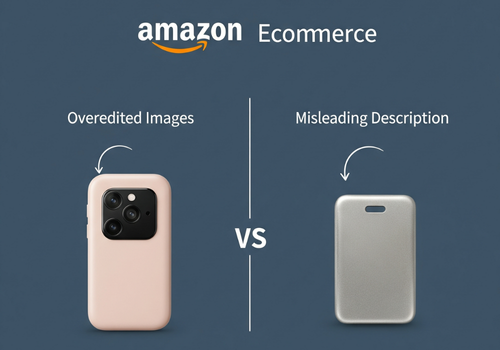Beware of Amazon Listing Tricks That Make Products Seem Better Than They Are — Learn to Spot the Lies
Overuse of Buzzwords and Unverified Claims in Titles and Bullets
Many Amazon listings lead with powerful marketing terms like “Doctor Approved,” “Clinically Proven,” or “#1 Rated” — even when there’s no real proof. These phrases are designed to build trust fast but are often unsupported by any real certifications or evidence. Sellers rely on these buzzwords because they trigger emotional buying decisions. Learn to question overly confident claims in product titles and bullet points, especially when no third-party validation or scientific backing is offered. Always scroll down to read the product details and disclaimers, and verify whether the product has certifications like FDA registration, CE marking, or other quality standards.
Heavily Edited Product Images That Hide Flaws
Product images on Amazon are often heavily edited to make items look sleek, shiny, or larger than life. Backgrounds are digitally enhanced with lighting effects and vibrant colors to make the product “pop.” But what you see isn’t always what you get. In some cases, supplement pills or gadget sizes are exaggerated, textures are smoothed, or labels are manipulated. The safest way to judge real product quality is by scrolling through the user-uploaded images in the review section. These real-world photos are your best chance at seeing what the item actually looks like outside of a professional studio.
Paid or Manipulated Reviews That Overhype the Product
High-star ratings can be misleading. Many sellers use incentivized review services or even fake accounts to flood their product with five-star ratings and glowing feedback. If a new product has hundreds of reviews and nearly all are positive, it’s a red flag. Use tools like Fakespot or ReviewMeta to analyze the authenticity of reviews. Also, take time to read low-star reviews, which often reveal recurring problems that the top reviews ignore. Pay attention to repetitive phrases, generic comments, or multiple reviews posted within a short period—they could be signs of manipulation.
Hiding Key Information in the Fine Print
Some Amazon listings bury crucial product details deep in the technical specs or under expandable sections. For example, a supplement might claim “90 capsules” in the title, but the fine print reveals it’s only a 30-day supply if you take the full recommended dose. Other times, a product may not be eligible for returns or may be shipped from another country, increasing delivery time or risk. Always scroll through every section of the product page, including “Product Description,” “Important Information,” and “Customer Questions & Answers” to make sure you know exactly what you’re getting.
Using Bundling and Comparison Charts to Mislead Buyers
Many listings use comparison charts or bundled offers to make their product seem superior. For instance, a supplement might compare itself to competing brands and claim to offer “more active ingredients” or “100% organic” without showing the source of these claims. These visuals often lack third-party verification or misrepresent competitors. Similarly, bundling poor-quality accessories with the main item (like charging cables or sample pouches) can inflate perceived value without improving the actual product. Always check if each item in a bundle is useful, necessary, and fairly priced on its own.
Fake “Limited Time Deals” That Create False Urgency
One common psychological trick is the use of countdown timers, “Only 3 left in stock,” or “Deal expires in 2 hours” messages to pressure shoppers into buying quickly. These tactics are often pre-programmed and reset continuously to create a false sense of urgency. Sellers know that urgency shortens decision-making time and leads to impulse purchases. If you’re not 100% sure about the product, take a moment, walk away, and come back later. Often, the “limited-time” price will still be there, or it may even drop further.
Conclusion: Don’t Let Polished Listings Fool You — Trust Your Research
In a marketplace filled with sleek photos, glowing reviews, and flashy titles, it’s easy to get tricked by a product that looks amazing but underdelivers. But once you understand how sellers use psychological tricks, digital design, and selective wording to influence your decisions, you can shop smarter. Always look past the surface—verify claims, read real reviews, and question urgency cues. Your best defense is awareness. By recognizing these Amazon listing tricks, you protect not only your wallet but also your health, safety, and satisfaction as a smart online shopper.

